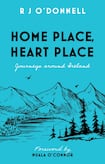
Inquisitiveness feeds our appetite for travel and the thirst to know what lies over the hill or across the river motivates many journeys. Roisin O’Donnell’s meandering tour of Ireland ticks all the boxes with an exploration of 30 locations from Kerry to the Glens of Antrim.
Her blend of heritage and distinctive wry humour produces a series of concise anecdotal essays. At each site the author is accompanied by a guide. Her vignettes are filled with idiosyncrasies and a concatenation of observations ranging from antiquity and local lore to the built heritage, bogs and landscapes.
Walking routes take her up the hills of Tara and Uisneach and down into the cramped space of the Ownagat cave at Rathcroghan where she worries that her body is not fit for purpose. She follows in the footsteps of Michael Davitt, writes movingly of the poet Francis Ledwidge killed in the first World War and joins tours of the pilgrim path to Ballintubber Abbey and the Tulach Beaglaigh mountain walk in Donegal. After experiencing the equinox at Loughcrew, she relishes the area around the Boyne which she characterises as “archaeological heaven”.
[ Plan for hotel near Rock of Cashel would harm ‘integrity’ of site, council toldOpens in new window ]
[ An Irishman’s Diary on Jack B Yeats and the woman who met Blind RafteryOpens in new window ]
One of her quests is to find the grave of the blind wandering poet and musician Anthony Raftery who composed during the Tithe War of the 1830s at Killeeneen in south Galway . She is intrigued by those influenced by him, including Lady Gregory who chose a single word for the headstone she commissioned, Raifteiri, echoing the blind wanderer Homer. A modern-day bard, Christy Moore reflects on his Kildare boyhood and memories of his parents as well his favourite places including Clongorey in the Bog of Allen, Pollardstown Fen and Donnelly’s Hollow. Moore enjoys “knockin’ about Ireland”, in much the same way as O’Donnell has done.
READ MORE
The author has marshalled a formidable array of little-known information: Cardinal Cullen banned the polka in the mid-19th century, Inishkea North island supplied the purple pigment that dyed the robes of Byzantine emperors, while the trumpa créda from the site of Emain Macha is in the National Museum, Dublin. This is an affectionate portrait of an older Ireland that many will not know; seen through the eyes of locals, the engaging stories and legends dovetail with the author’s lively inquiring mind.












